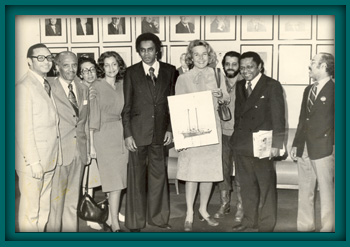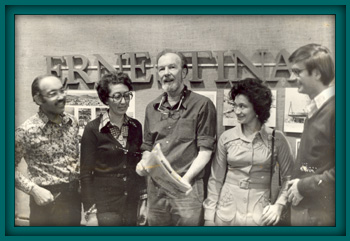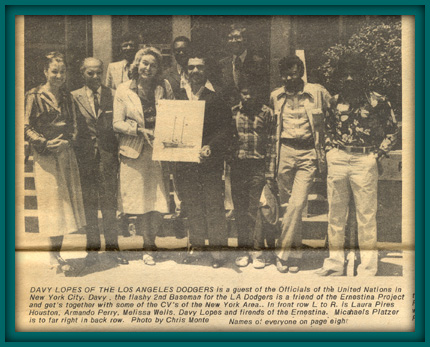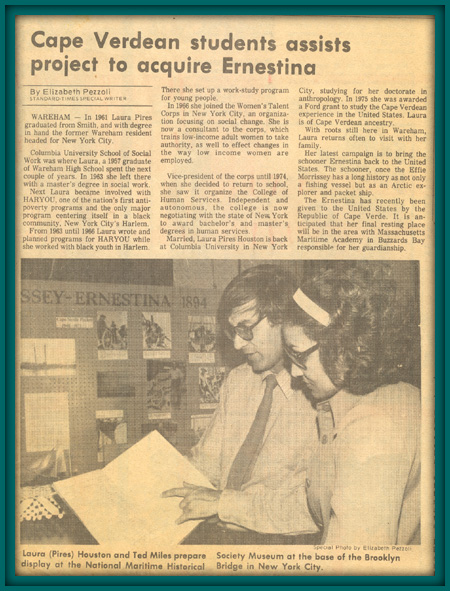|
The
effort to bring Ernestina back to America mounted.
Within a year, Friends Chapters were organized in Boston,
New Bedford, New York area, Providence, Scituate, and
Wareham-and later in Bridgeport and Rye. Conferences and
meetings were hosted by the American Sail Training
Association, Bridgeport Cape Verdean Women’s Social
Club, Cape Verdean-American Federation, Cape
Verdean-American Veteran’s Association, Cape Verdean
Educator’s Collaborative, Cape Verdean Recognition
Committee, Cape Verdean Women’s Auxiliary (NY), Cape
Verdean Relief Association, Clearwater, Inc., Durland Sea
Scout Center (Rye), First World Alliance, Mystic Seaport,
National Maritime Historical Society, National Trust for
Historic Preservation, City of New Bedford Community
Development Department, New Bedford Folkloric Troupe,
Providence Corporation, UNIDADE (Bridgeport), Town of
Wareham Community Development Department, and Wareham
Historical Society. Contributions were made by many of
these organizations as well as the American Bureau of
Shipping, Hope Settlement House and Day Care Center,
National Maritime Union and others.  The
photo to the right shows the Ernestina Committee meeting with Cape
Verdean Ambassador Amaro Da Luz and American Ambassador to Cape Verde,
Melissa Wells, at the UN in June 1978. (l to r) Consul General of
Boston, Armando Perry, Cecelia Monte, Laura Hester, Amaro DaLuz, Melissa Wells,
Eddie Andrade, Luiz Fernandes (CV Ambassador to Guinea Bissau), and Joe Monte. The
photo to the right shows the Ernestina Committee meeting with Cape
Verdean Ambassador Amaro Da Luz and American Ambassador to Cape Verde,
Melissa Wells, at the UN in June 1978. (l to r) Consul General of
Boston, Armando Perry, Cecelia Monte, Laura Hester, Amaro DaLuz, Melissa Wells,
Eddie Andrade, Luiz Fernandes (CV Ambassador to Guinea Bissau), and Joe Monte.
 The
photo to the right shows Joe Monte, Cecelia Monte, Pete Seeger, Laura
Pires and Michael Platzer during a fund raiser in at the National
Maritime Historical Society in Brooklyn, NY in June 1978. The
photo to the right shows Joe Monte, Cecelia Monte, Pete Seeger, Laura
Pires and Michael Platzer during a fund raiser in at the National
Maritime Historical Society in Brooklyn, NY in June 1978.
Providence
Corporation arranged for a donation of masts from
Canadian Transport Company transported from British
Columbia by Seaboard Shipping Corporation. Providence
local longshoremen loaded them without cost and
transported them to Cape Verde aboard a Cape Verde
steamship. Individuals donated blocks, sails and safety
equipment. Friends Chapters sent tools and supplies. The
New Bedford Folkloric Troupe sent a pump. William Baker,
famed Ship Historian and consultant for the National
Trust, prepared a Sail Plan for Historic Preservation.
Cummins Engine Company contributed new parts for the old
Engine and sent an engineer from Darlington, England to
help install them.

John Braman, a United States volunteer in Cape Verde
on a special Humpback Whale research project, spent time
working on repairs and located the Dutch Shipwright,
Franz Meijer, who agreed to work in Cape Verde on the
restoration. The shipwright was supported financially for
14 months by the National and local Friends Chapters.
Special effort to keep the project continuing came from
John Braman, Oling Jackson, Laura Pires Houston, Edward
Andrade, Joe Monte and Julius Britto. A daughter was born
in Cape Verde to Franz Meijer, the shipwright in 1978.
In recognition of broad-based citizen efforts, the
National Endowment for the Humanities awarded a
multi-year grant totaling $30,000 to the National Friends
Committee. Spearheaded by Laura Pires Houston and the
National Maritime Historical Society, these funds
supported the development, design and construction of an
eight panel exhibit, "Ernestina: The Human
Story."

The Massachusetts Schooner Ernestina Commission
was established in 1978 to receive official title to the
returned schooner. State Representative Thomas D. Lopes,
with support from Senator George Rogers, sponsored the
enabling legislation establishing the Commission. [Today
Tom is editor of the Cape Verdean News (CVN) based in New
Bedford]. With the Commission in place, the
organizational structure of the movement was fleshed out:
a central coordinating National Friends Committee;
several local support building chapters; and a
legislatively-based Commission. The movement’s broad
base is exemplified by the involvement and co-leadership
of people from diverse cultural, geographical and ethnic
backgrounds.
|